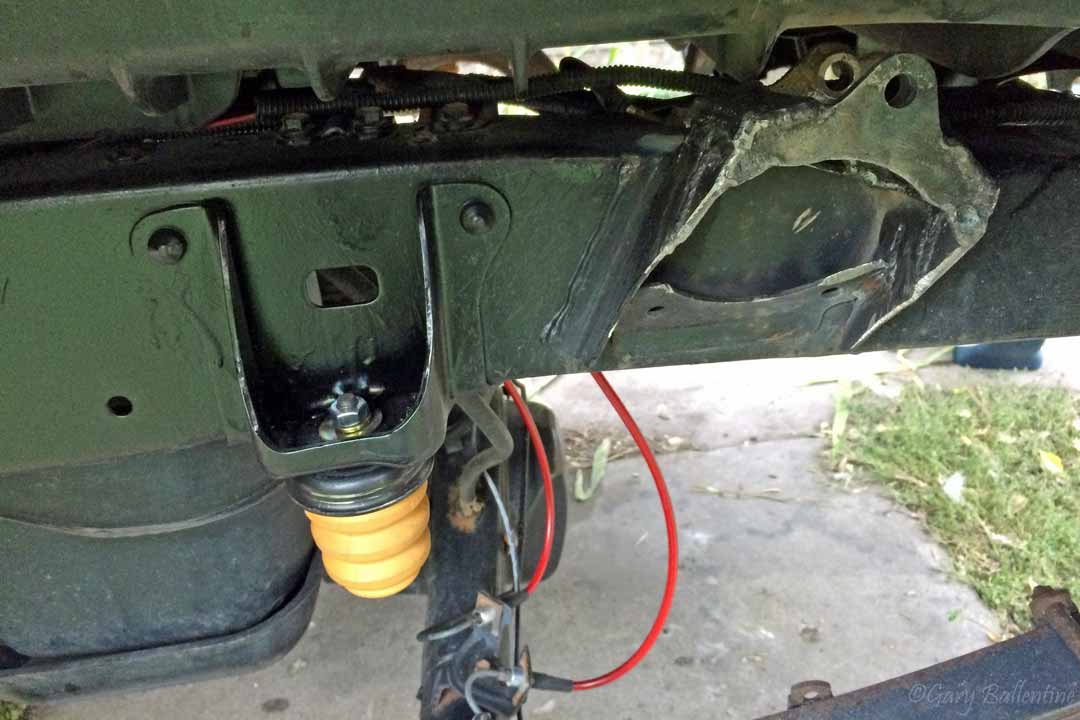Project Overland: Tacoma Suspension

The Evolution of the Black Pearl
The suspension on the Black Pearl has been slowly evolving over the last 10 years. She was bone stock when I bought her at 120,000 miles, at which point the factory suspension was completely shot from the original owner hauling dirt bikes in the back on a regular basis (not to mention the tailgate was bent from loading them). The stock leaf springs were pretty pathetic to begin with, and were even recalled by Toyota in 2014 because they were breaking on people. The Pearl got a full suspension replacement within a month of finding her new home, but the mods didn’t stop there.

Sitting on a 2.5″ OME lift with 265/75/R16 Duratracs
Old Man Emu 2.5” Lift Kit

885 Springs, Nitrochargers, and original SPC Control Arms
Going Mid-Travel: SPC Upper Control Arms
To correct the alignment issue and give me some caster back, I went with SPC upper control arms. These are the most affordable option for Tacomas and the newest version has proven reliable. Their initial design, however, was flawed and one of them actually broke on me when I was driving. I knew something was wrong when the entire truck bobbed up and down each time the front passenger tire hit a bump. Not good.
SPC was great to work with and mailed out replacements immediately. I’ve put about 30,000 miles on the new ones and they’re holding up great. The balljoints are showing some slight wear, but for the punishment they’ve been through I’m not surprised. They’re holding up better than most balljoints would and are still well-within spec.

Broken SPC control arm that was promptly replaced under warranty
Bilstein 5100 Series Shocks
When the OME shocks bit the dust at about 30,000 miles, I was less than impressed. In all fairness though, they had been heavily used and subjected to 60mph desert runs that would make any monotube design fade and eventually fail. They gave decent performance for what they were, and probably would have been fine for city driving and going slow offroad, but what fun is that?
I swapped in a set of Bilstein 5100 shocks because funds were tight at the time, and honestly I liked them better than the Nitrochargers. Small bumps were slightly more pronounced, but medium and big bumps and whoops were much smoother, even on pavement. The shocks were still going strong when I sold them after 20,000 miles a few years later.

The road salt took its toll on the Bilstein’s zinc plating
Fox Remote Reservoir Coilovers and Rear Shocks
After years of trial and error, I finally came to my senses (and saved up enough money) and bought Fox remote reservoir coilovers. Why? Because every monotube design I used faded in about 10 minutes when I took the Pearl out into the desert. She isn’t a prerunner, but I get impatient when there’s 20 miles of washboard road in front of me in the vast expanse of the southern Utah desert. After giving them a few test runs, I knew I made the right decision.
Why I chose Fox
King, Bilstein, Icon, and Fox all make great quality remote reservoir shocks and coilovers, but not all of them give the broad performance that Fox does. Bilstein and Icon, for example, use digressive valving. This means they actually get softer as the bumps get bigger, giving you stability on smooth sections while readily soaking up big bumps and whoops. This also means they give you a bone-jarring ride, with small pebbles not feeling much different than grapefruit-sized rocks. Bilstein is a bit more tolerable here, but Icon especially is known for giving a rough ride on pavement and smooth sections of trail.
Fox and King shocks implement progressive valving, and it’s no surprise that they’re the most common choices among professional racers. They also give the best ride both on-road and off. Small bumps feel like they aren’t even there, and despite the shock getting stiffer as the bumps get bigger, they still soak them up and feel almost bottomless when sailing at 60mph in the desert.
Ride quality is not terribly different between Fox and King, with the Fox’s being a bit on the soft side but still very stable and also revalvable. The main reason I chose Fox is because the design is beefier and arguably higher quality, with larger-diameter rods that are made from stainless steel instead of chrome-plated carbon steel. They salt the roads out here, and for this reason alone it was worth it for me to get the Fox’s.

Fox Factory Series RR coilovers installed
Factory Series Vs. Performance Series
There really is no contest here. The Factory Series is Fox’s tried and true race line of shocks. It uses the highest quality materials and the strongest design. The Performance Series is by no means bad, but they are application-specific, street-oriented, and not meant to be revalved. They are a cheaper, lower-performing design that is meant to compete with shocks like the Bilstein 5100 while still being a step up in performance (it’s Fox afterall). If the Performance Series is a Chevy Camaro, then the Factory Series is a Corvette.
Coilover Protection
Rear shocks
The factory shock mounts on the Tacoma use stems on the upper mounts, which are cheap and easy to install but prone to breakage under heavy use. If you search the web, you will find reports of rear upper shocks snapping off from heavy use (i.e. abuse). By cutting off the factory shock mounts and welding up my own design with generic shock tabs, I was able to fit the Fox Factory Series 2.0 11” universal shock. Not only is this a stronger design than any shock made for the truck, but it’s longer too, giving me more suspension travel.

Custom-fabbed rear shock mounts with Fox Factory Series 2.0 11″ shocks
Rear Leaf Springs
The OME Dakar leaf springs from the original lift are still going strong and I’ve chosen to keep them. I’ve adjusted their spring rate a few times by removing and reinserting a leaf, and ultimately left them in their stock configuration. The ride is a bit rough with an empty bed, but when it’s loaded up with gear the spring rate is about perfect. For a truck that doesn’t have much weight in the rear, I would definitely remove a leaf to soften the ride.
Progressive Bump Stops
While highly effective pneumatic designs exist, they’re expensive and usually unnecessary. I installed progressive bump stops front and rear, using Wheeler’s Superbumps in the front and adapting some generic Dorman jounce bumpers in the rear. The rear was easy to do, I just drilled a hole and bolted them in.

Generic progressive bump stops and the first iteration of the custom shock mounts
U-Bolt Flip
Brake Lines
The front factory brake lines were long enough even with the lift, although I still might replace them in the future with longer braided lines for improved reliability and braking performance (the stock brake lines expand slightly when braking, braided SS lines will transfer power to the brakes more effectively).
The Result
The suspension is finally where I want it, although I might revalve the rear shocks at some point. Currently they’re set to 30/90, and realistically I think 30/70 or 40/70 would be a better match for the Pearl. She absolutely flies through the desert though, eating up bumps and dips like they’re Gordon Ramsay’s Beef Wellington. Suspension articulation is great for an IFS rig, and the road manners are the best they’ve ever been. I really like how soft the Fox coilovers are for road use, and offroad they stiffen up nicely when the trail gets rough.
Shock fade is not an issue anymore thanks to the remote reservoirs, and the ride is surprisingly stable despite having the sway bar removed (although I won’t recommend that you remove yours for safety reasons, and I do put mine back on for heavy towing). I can go 60 over washboard roads all day long and not have to worry about the suspension. The Fox Factory Series gets two thumbs up from me.


Tacoma Bed Platform and Storage
Raised sleeping platform with storage for gear
